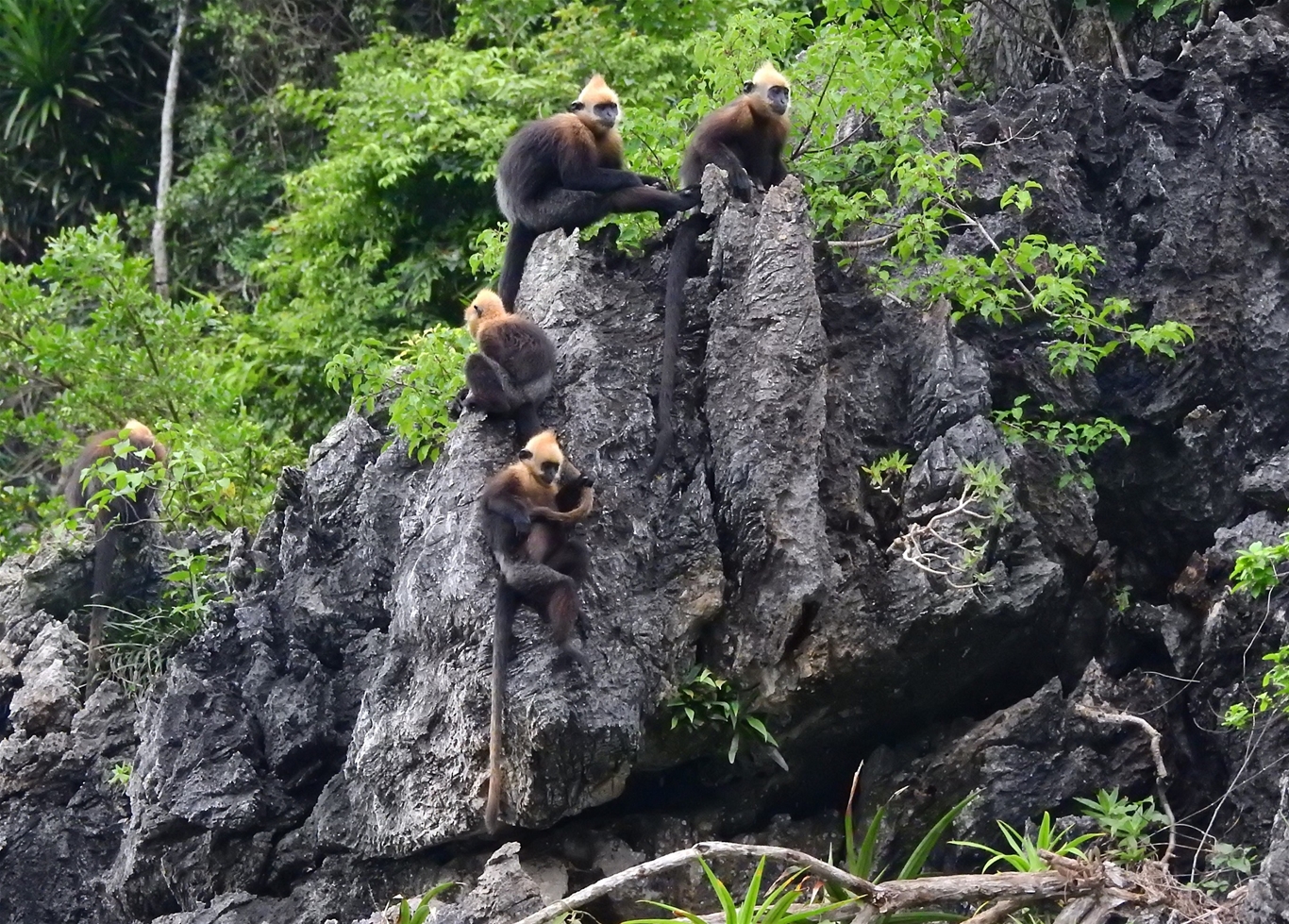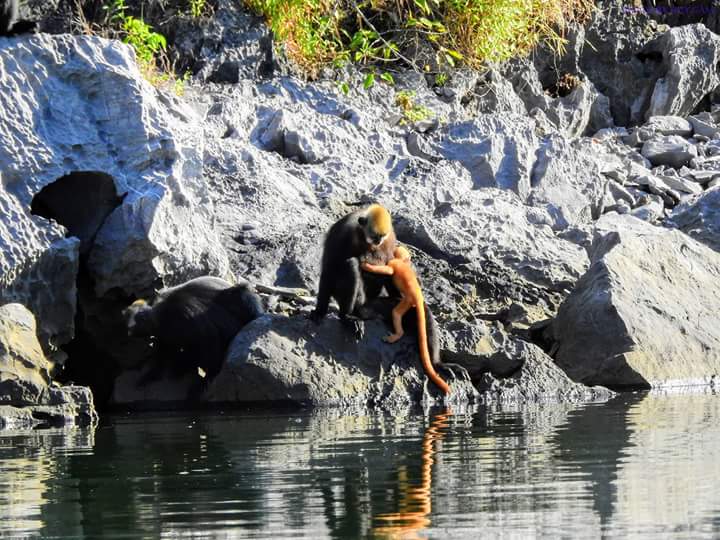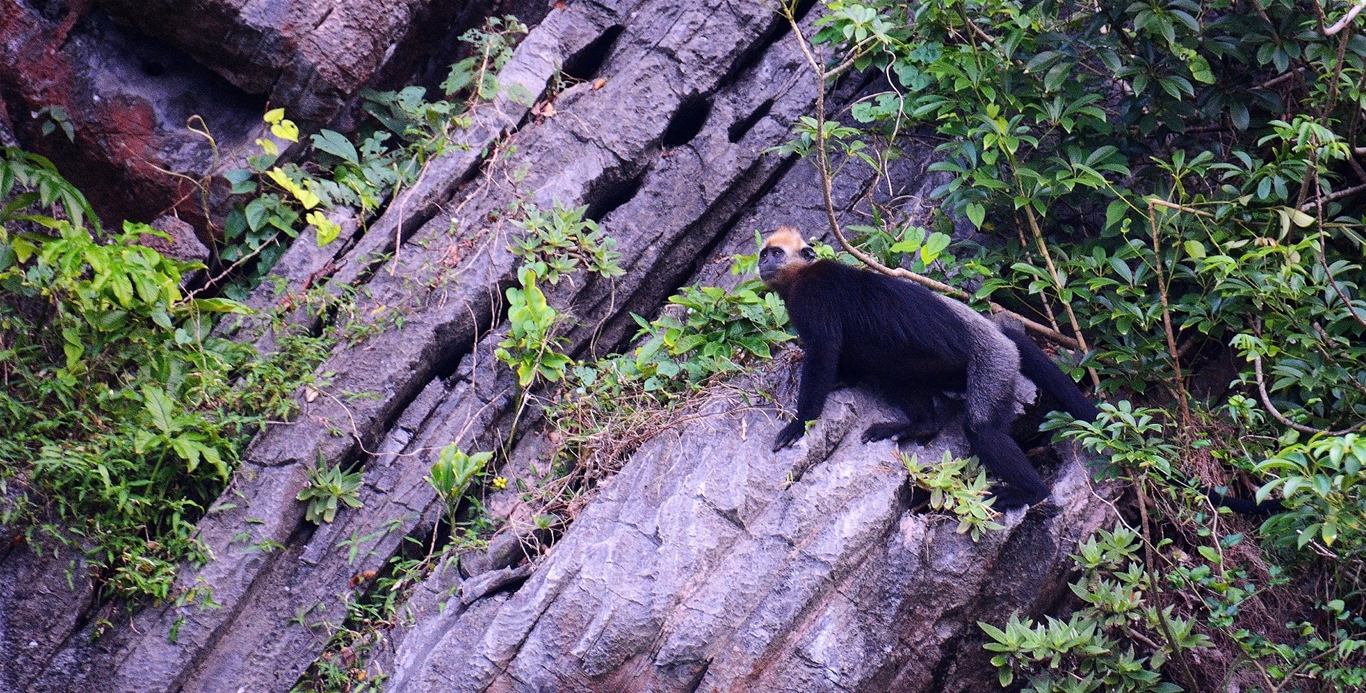 Cat Ba Langur (Yellow-headed Langur)
Cat Ba Langur (Yellow-headed Langur)
 Also known as Yellow-headed Langur, scientific name Trachypithecus poliocephalus policephalus, English name is Cat Ba langur or Golden headed langur, is one of the four endemic primate species of Vietnam, they only live in the forests on the limestone mountains of Cat Ba archipelago, Hai Phong city with a small number of individuals.
Also known as Yellow-headed Langur, scientific name Trachypithecus poliocephalus policephalus, English name is Cat Ba langur or Golden headed langur, is one of the four endemic primate species of Vietnam, they only live in the forests on the limestone mountains of Cat Ba archipelago, Hai Phong city with a small number of individuals.
 At birth, young Cat Ba langurs have brilliant orange-yellow fur. From April, their body hair color begins to gradually turn black, especially from the shoulder to the top of the head, it remains bright yellow. Young langurs have a long childhood, are cared for by adults in the herd and taught survival skills. As they mature, the color of the hair on the Cat Ba langur's head becomes lighter, so looking at the hair on the head we can guess their age. The hairs on the head form a pointed crest. The skin on the face, ears, hands and feet is dark black.
At birth, young Cat Ba langurs have brilliant orange-yellow fur. From April, their body hair color begins to gradually turn black, especially from the shoulder to the top of the head, it remains bright yellow. Young langurs have a long childhood, are cared for by adults in the herd and taught survival skills. As they mature, the color of the hair on the Cat Ba langur's head becomes lighter, so looking at the hair on the head we can guess their age. The hairs on the head form a pointed crest. The skin on the face, ears, hands and feet is dark black.

 Adult Cat Ba langur has a body length of about 47 to 53cm. In particular, their tail is much longer than their body, about 85 to 90cm and helps them keep balance while moving on craggy and dangerous limestone mountains.
Adult Cat Ba langur has a body length of about 47 to 53cm. In particular, their tail is much longer than their body, about 85 to 90cm and helps them keep balance while moving on craggy and dangerous limestone mountains.
 Adult from 4 to 6 years old Cat Ba Langur gives birth only once, and the interval between births is about 2 years. The lifespan of Cat Ba Langur is about 25 to 30 years old. The forests on the craggy limestone ridges of the Cat Ba archipelago are the only habitat of the Cat Ba langur. During the day, they are active on tall trees, feeding and resting on them. At night, they sleep in burrows or cliffs and cliffs on those rocky mountains to avoid inclement weather.
Adult from 4 to 6 years old Cat Ba Langur gives birth only once, and the interval between births is about 2 years. The lifespan of Cat Ba Langur is about 25 to 30 years old. The forests on the craggy limestone ridges of the Cat Ba archipelago are the only habitat of the Cat Ba langur. During the day, they are active on tall trees, feeding and resting on them. At night, they sleep in burrows or cliffs and cliffs on those rocky mountains to avoid inclement weather.

 Cat Ba langurs have the habit of living in groups like family units, with a male as the head of the family, leading the herd to forage, warning about possible threats to the family and find a place to sleep.
Cat Ba langurs have the habit of living in groups like family units, with a male as the head of the family, leading the herd to forage, warning about possible threats to the family and find a place to sleep.
 When sensing danger, the leader of the herd will stand on a high mountain to warn the whole herd. Their food is leaves, a few other are flowers, forest fruits: fruits of Banyan tree, Buddha of the mountain ..., especially, due to the structure of the stomach and large liver, Cat Ba langur can eat poisonous leaves and fruits such as: toenail leaves, periwinkle fruits.
When sensing danger, the leader of the herd will stand on a high mountain to warn the whole herd. Their food is leaves, a few other are flowers, forest fruits: fruits of Banyan tree, Buddha of the mountain ..., especially, due to the structure of the stomach and large liver, Cat Ba langur can eat poisonous leaves and fruits such as: toenail leaves, periwinkle fruits.
 The animal is endemic to Cat Ba Islands and has long become the pride of the people here. However, the Cat Ba langur is in an extremely endangered state, facing a high risk of extinction. Currently, the population of Cat Ba Langur on the whole Cat Ba archipelago is still a fragile population, with the number of only about 65 individuals. Faced with the above risk, but fortunately, the Cat Ba langur herd has been and is a species of special concern and protection by not only the Cat Ba Langur Conservation Project, a conservation program with the highest goal of ensure this species from extinction, but also by all important agencies and organizations on Cat Ba island such as Cat Ba National Park, Cat Ba Biosphere Reserve...
The animal is endemic to Cat Ba Islands and has long become the pride of the people here. However, the Cat Ba langur is in an extremely endangered state, facing a high risk of extinction. Currently, the population of Cat Ba Langur on the whole Cat Ba archipelago is still a fragile population, with the number of only about 65 individuals. Faced with the above risk, but fortunately, the Cat Ba langur herd has been and is a species of special concern and protection by not only the Cat Ba Langur Conservation Project, a conservation program with the highest goal of ensure this species from extinction, but also by all important agencies and organizations on Cat Ba island such as Cat Ba National Park, Cat Ba Biosphere Reserve...

 The population of Cat Ba langur has been in sharp decline since the 1960s. The decline is increasing in proportion to the increase in settlements and population growth on Cat Ba Island in the following decades. From the 1970s to 1986, the decline rate of Cat Ba Langur was increasing. Not only that, they are also divided into small and unrelated subpopulations. The decline in the population of Cat Ba Langur has occurred in both the size of the herd and the number of individuals in the herd. In previous years, Cat Ba langur was threatened by many factors, of which hunting was the main cause of the decline of this population.
The population of Cat Ba langur has been in sharp decline since the 1960s. The decline is increasing in proportion to the increase in settlements and population growth on Cat Ba Island in the following decades. From the 1970s to 1986, the decline rate of Cat Ba Langur was increasing. Not only that, they are also divided into small and unrelated subpopulations. The decline in the population of Cat Ba Langur has occurred in both the size of the herd and the number of individuals in the herd. In previous years, Cat Ba langur was threatened by many factors, of which hunting was the main cause of the decline of this population.
 It is estimated that within 40 years from 1960 to 1990, Cat Ba Langur has lost about 98% of its population size. This is a sad reality for the existence of one of the rarest primates in the world. Most of the remaining langur populations are distributed in areas where it is most difficult to have a chance to survive past hunting. Habitat loss combined with low reproduction rates are also threats to Cat Ba Langur. In addition to hunting, which has been controlled by the Cat Ba National Park Ranger, the process of natural selection also leads to population loss, such as conflicts over herd that lead to death but severe injuries to individuals. Fighting to kill the young reduces the next generation of future reproduction, the aging rate leads to fertility, inbreeding leads to the degradation of the species.
It is estimated that within 40 years from 1960 to 1990, Cat Ba Langur has lost about 98% of its population size. This is a sad reality for the existence of one of the rarest primates in the world. Most of the remaining langur populations are distributed in areas where it is most difficult to have a chance to survive past hunting. Habitat loss combined with low reproduction rates are also threats to Cat Ba Langur. In addition to hunting, which has been controlled by the Cat Ba National Park Ranger, the process of natural selection also leads to population loss, such as conflicts over herd that lead to death but severe injuries to individuals. Fighting to kill the young reduces the next generation of future reproduction, the aging rate leads to fertility, inbreeding leads to the degradation of the species.

 In recent years, Cat Ba has attracted a very large number of tourists and in the coming years will surely continue to increase. If not well controlled, tourism will be a risk to the habitat of all species. As the most precious primate in the world, the Cat Ba langur cannot be viewed as a tourist attraction until their numbers increase to a safer number. The current very critical situation of Cat Ba Langur will take many more years to improve.
In recent years, Cat Ba has attracted a very large number of tourists and in the coming years will surely continue to increase. If not well controlled, tourism will be a risk to the habitat of all species. As the most precious primate in the world, the Cat Ba langur cannot be viewed as a tourist attraction until their numbers increase to a safer number. The current very critical situation of Cat Ba Langur will take many more years to improve.
 Cat Ba langur, an extremely rare natural property not only of Cat Ba, Vietnam but also of the world and is currently at very high risk of extinction. Therefore, it is necessary to have international cooperation, cooperation of many non-governmental organizations in conservation work to have effective measures and funding sources, as well as international experiences to protect species from being destroyed, extinction, and restore and develop the Cat Ba langur population.
Cat Ba langur, an extremely rare natural property not only of Cat Ba, Vietnam but also of the world and is currently at very high risk of extinction. Therefore, it is necessary to have international cooperation, cooperation of many non-governmental organizations in conservation work to have effective measures and funding sources, as well as international experiences to protect species from being destroyed, extinction, and restore and develop the Cat Ba langur population.


